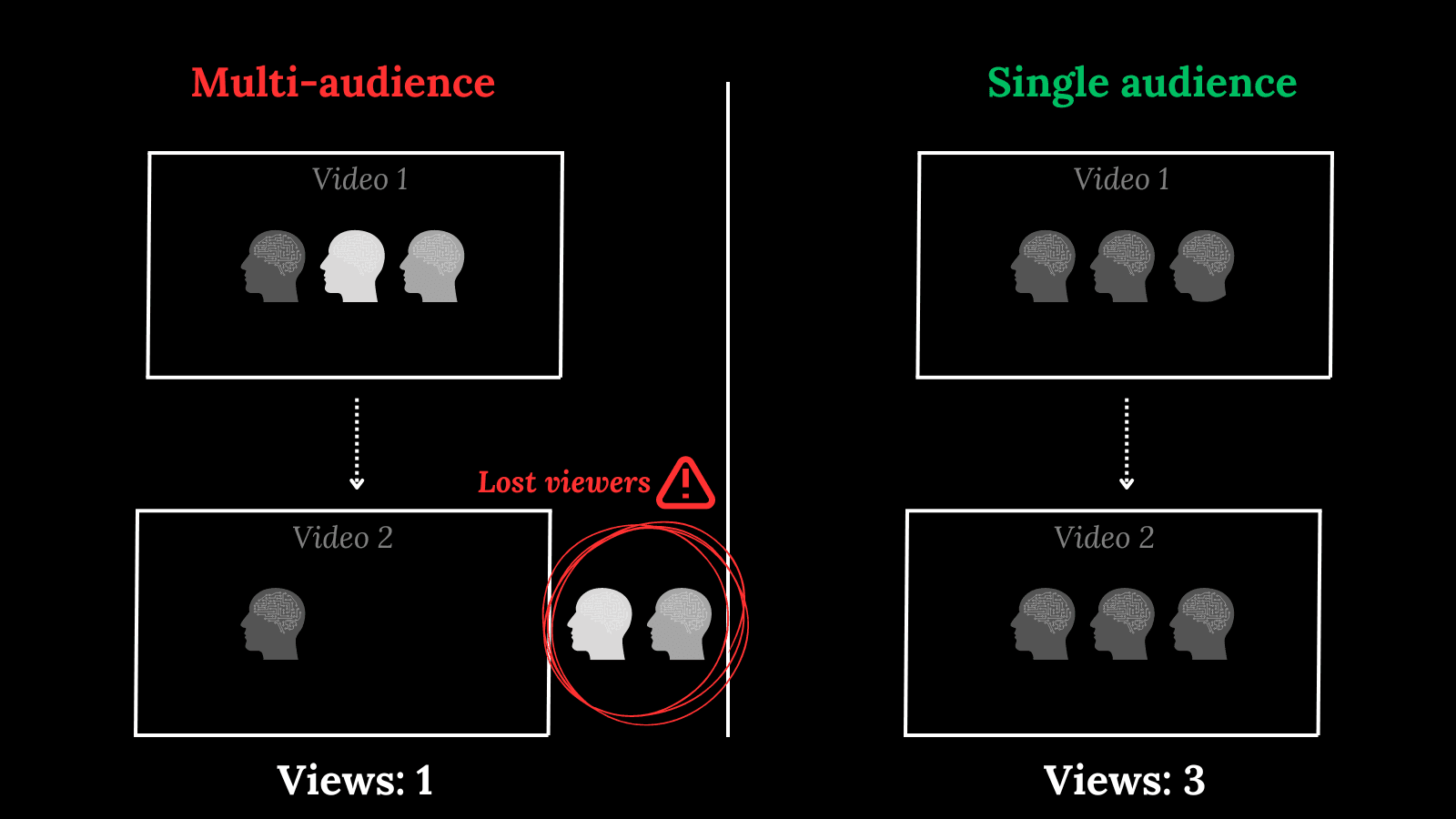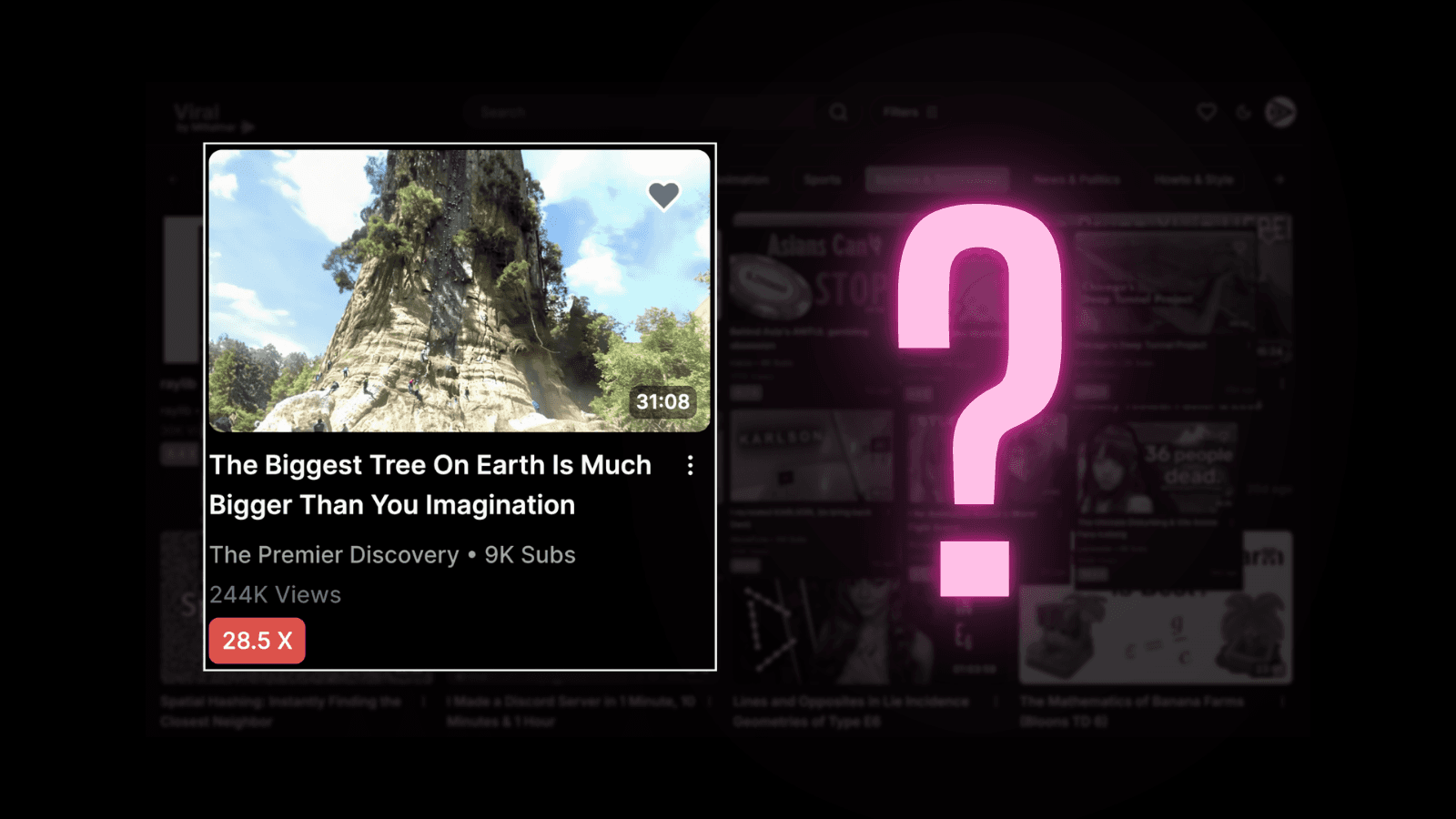Sep 25, 2024
How To Validate A YouTube Video Idea
Aleksander
How do you know if a video idea is worth pursuing? How can you measure it’s chance of success to reduce the risk of flop? In this blog post we cover…
Why your video topic must align with your content
Why bottlenecks and non-biased feedback matters
How you can validate a YouTube topic using different metrics
What these metrics are and why they work to measure a videos potential success
Why outliers work to produce viral video
The First Step: Basics matters
The very first and simple step to validate a Youtube video topic, is to check if it fits with your channel offering.
Your channel offering is the type of videos you produce; does the video idea align with the general theme and style on your channel? If you produce videos about “Minecraft PVP”, a video about “Fortnite” should be out of the question.

If the video topic is not in line, it can harm your channel over time if you are trying to build a consistent and loyal audience. Therefore, it is crucial to develop a theme with your videos, and your next video must be aligned! This is very important, and yet, so many forget it.
The second step is also a basic and it is all about execution.
The topic doesn't matter if you can’t deliver on essentials like video packaging (intro hook, title, thumbnail) and production quality. This must be in place, otherwise, you can't tell if your topic is your problem or whether it's linked to these processes. That's why you need to solve these issues first. Always attempt to identify your weakest link (bottleneck), the most important area you need to improve upon in your production line.

If you struggle to identify your bottlenecks, get non-biased feedback from other YouTubers. This is especially useful if they have more experience than yourself. The more people you ask, the larger the data sample, and the higher the quality of the feedback (crowd wisdom). Advise can be dangerous, so make sure it all makes sense! In some cases, it makes more sense to listen to one's intuition.

How To Validate a YouTube Video Topic
In our last blog post, I wrote about how you can use outliers to identify video ideas with proven demand, and that these outliers can serve as inspiration to create your own viral videos.
To quickly recap; outliers are viral videos that perform exceptionally well compared to a channel’s average results. They are essentially viral videos and shows what is wanted from viewers on YouTube. It is a proven video concept that works and signals true demand from viewers. It shows what the YouTube algorithm wants.
But why is that? Why can we trust outliers? It all comes down to the following metrics:
Supply and demand
Momentum
Narratives
Sounds complicated, eh? Let’s break it down simple and stupid.
Supply and demand
Let’s use a simple example of Minecraft videos to illustrate supply and demand on YouTube:
Supply = Minecraft videos being uploaded by Minecraft YouTubers
Demand = YouTube viewers watching and wanting Minecraft videos
Whenever there’s a larger demand from viewers than there is supply coming from Minecraft content creators, there’s an opportunity in the market for Minecraft YouTubers.
Let’s say the demand is 7 videos a week, but only 2 videos is uploaded. Then those 2 videos will likely gain lots of views because there is too few videos being uploaded to satisfy the demand.
On the contrary, if the demand is 7 videos a week, but Minecraft YouTubers upload 21 videos per week, some Minecraft YouTubers will not get a lot of views due to a crowded market.

The best way to measure supply and demand for a topic, is to look at supply and demand for a similar type of video. This can be difficult, but here’s the step-by-step guide to do it.
Search for the topic you intend to make on YouTube. I am using an outlier I found with Viral Dashboard as an example.

Find the videos most similar to the one you will make. This includes the videos that comes up first when searching for the topic, but you also the most recent videos this past month (use filter mechanism)


Now, look at views-to-subscribers ratio for the different videos, to see if video views is higher than the channel’s subscribers.
The first video is 10 months old, but is an impressive outlier. It has 6 600 000 views while the channel has 860 000 subs, giving a 7,67x views-to-subscribers ratio (very impressive).
The next video (that appears in both searches) has 857 000 views and 456 000 subs, meaning it is a 1,87x views-to-subscribers ratio.
The last video has 617 000 views and 14 300 subs, giving it a very impressive 43,14x ratio.
All ratios have more views than subscribers, indicating that there’s currently a very large demand for the topic. It’s important to emphasize that newer videos gives more accurate feedback on the current state of supply and demand, because it’s a fresher signal. YouTube viewers continually change what they view. The newer, the better. In our case, one of the videos was just 7 days old, which is a very telling sign (positive).
However, if you find a lot of negative ratios, the demand might not be as strong. But take the metric with a grain of salt, because there are exceptions. You might find negative ratios plus a brand new video that has a very good ratio. This could be an indication that the search is currently breaking out. Every search will be different, but at least you want some of the views to have a positive views-to-subscribers ratio!
Important: note that supply and demand is just one metric, and is not alone sufficient to validate a video. That’s why momentum matters.
Momentum
While supply and demand gives us some signals for the short and medium-term, momentum gives us the best metric on a day-to-day basis, or hour-to-hour basis. What is momentum? It can be measured using VPH (views-per-hour). If you have high views per hour on a video it signals that there’s high demand for it right now as we speak. Pairing these two metrics together gives us very powerful signals.

The caveat here, is that it doesn’t necessarily tell you exactly what it is about the video that there is a large demand for. That is why it matters to look at other metrics to make a complete analysis. That brings us to the next metric which is narratives.
Narratives
What about the video is viral? If we break down this outlier for example, let’s look at the narratives.

The context here is that KSI, Mr. Beast and Logan Paul together launched a new meal that is processed garbage. This has caused an uproar by fans, and this video takes on KSI’s response to his fans. The following “objects” likely causing demand can be identified:
-KSI (his name and status attracts demand)
-Lunchables (this is trending, attracts demand)
-Angry fans (this is trending, attracts demand)
-KSI’s terrible reaction (framed as a terrible reaction, the narrative)

The total demand for the video is a sum of these objects and the interest based around them. If we remove one of the objects, the video certainly loses some of its potential demand. If we just make a video about KSI, it certainly could get some views, but together with the current narratives they create a powerful cocktail that has a surge in demand.
Try to breakdown your video and look at all the different objects that might cause demand, as it might tell you what exactly there is a demand for. Perhaps you could even introduce new objects that is currently high in demand to craft an even more powerful mix?
Important: I will again remind you that the video should be in alignment with your channel’s offering.
Survivability
It's not only the short-term metrics that matter. Videos should also be evergreen, meaning they continue to be relevant and provide views in the far future. Some ideas can deliver very high results in the short-term, but fails to provide any meaningful results over the long-term. Know what your strategy are, and the potential implications of your decisions. I describe this in more detail in this article if interested.
Viewer feedback

The YouTube comment section is a gold-mine, because it is the only place where your audience directly tells you what they think, it's pure signal. If you are trying to validate a YouTube video idea, look at the comment section of similar videos. Here you could find some confirmation of your video topic or related objects and narratives. While there's often a lot of noise here, some comments can really provide valuable insights.
Why Outliers Matters
Outliers almost always have a large demand from viewers, have a high VPH and automatically identifies videos which has narratives. That’s why outliers is such a valuable metric; they contain supply and demand, momentum and narratives all-in one.
This is why you need the software tool Viral Dashboard.

Viral Dashboard gives you a complete overview of outliers and hot video trends on YouTube; it’s a collection of thousands of video topics that contains proven demand, momentum and narratives. What benefits can you expect from Viral Dashboard you ask?
Remove boring and tiring tasks. Get instant access to all outliers
Save time. Reduce the research time for finding outliers by more than 90%
Get more views. Improve your video success rate and lower the risk of flops
Viral Dashboard helps you validate video ideas and give you instant access to outliers for just $9.99, a fraction of the market price.
As a thanks for reading this entire blog post, I am giving you a special coupon code: EARLYBIRD2024. That gives you 30% off for a year’s subscription of Viral Dashboard (that’s not even $6 month).
Subscribe today, and increase your chance of creating viral videos!
